Cleaning the Para Ordnance P-14 .45 ACP
|
Note that this is just the standard cleaning I do for everyday use.
Full disassembly and cleaning is recommended at least once a month for
firearms that are utilized often (as mine are).
Before starting this, read the Preparation page!
|
|

|
Pour a dab of solvent onto the brass brush... |

|
And scrub the entire inside of the slide. |
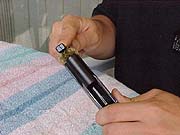
|
Also clean the ends of the slide... |

|
...and breech opening. |

|
This will loosen the lead deposits, gunpowder residue, and general contaminants within the slide. |
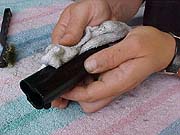
|
Once the entire slide has been scrubbed, use a soft cloth to wipe out the loosened contaminants. |

|
With the slide thoroughly cleaned and all excess solvent wiped out, pour a dab of gun oil on a cleaning pad. |
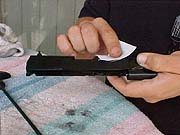
|
Generously apply the gun oil to the inside and outside of the slide. |

|
Once done oiling, take a clean cloth and polish the slide, removing all excess gun oil. When done, set the slide aside. |

|
Next take the barrel and, with the solvent... |
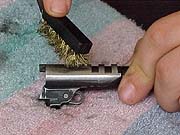
|
...clean the outside of the barrel; again, removing all lead deposits, gunpowder residue and other contaminants. |

|
Pay special attention to the loading-end opening of the barrel. Failure to clean this thoroughly will significantly contribute to jams when firing. |
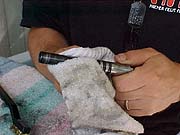
|
Wipe off the excess solvent from the outside of the barrel. |

|
Take the bore brush and dip it in the solvent. |
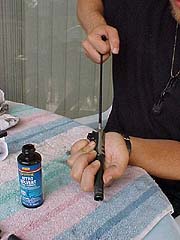
|
Thread the bore brush through the barrel. |

|
Make sure that the strokes fully exit the barrel on both the down and up stroke. |

|
Using the light-bending bar, inspect the inside of the barrel for remaining contaminants. |

|
The view will be something like this, only better illuminated. Take your time in inspecting the inside of the barrel. You may need to do more than one bore brush treatment to remove all the contaminants. |
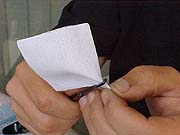
|
Once you are satisfied that the bore brush has done all it can do, prepare a lint-free cleaning pad to swab the inside of the barrel. |

|
Situate the pad so that it's seated firmly in the pad holder. |

|
Dip the cleaning pad in the solvent. |
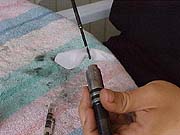
|
Slide the pad through the barrel just as you did with the bore brush. |

|
Again, make every stroke so that it fully exits the barrel. You will likely need to use more than one solvent-soaked pad until they start coming out of the barrel clean. (The picture here shows what a clean pad looked like going through the barrel just once.) |

|
Once the pads are no longer picking up noticeable contaminants, re-inspect the barrel interior with the light-bending bar. |

|
If no further cleaning is required, take a dry cleaning pad and affix it to the pad holder. Run the cleaning pad through the barrel just as you did the bore brush and wet cleaning pads. |

|
Once done, wipe off excess solvent from the outside of the barrel and apply the gun oil on the outside of the barrel only. Putting gun oil inside the barrel only helps contaminants stick to the inside of the barrel. |

|
Polish off the excess gun oil. |
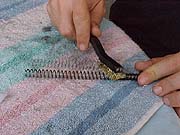
|
Using the solvent, clean off the spring assembly. |
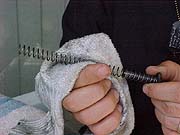
|
Once cleaned, wipe off solvent from the spring assembly... |
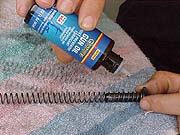
|
...and apply a small amount of gun oil. This is not so much to lubricate the spring as it is to prevent rust. |

|
With a clean pad, wipe off excess gun oil from the spring assembly. |

|
Clean and oil the spring plug. |

|
Clean and oil the bushing. |
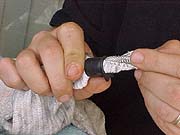
|
Use a cloth to thoroughly clean the inner wall of the bushing. As always, wipe off any excess solvent when done... |
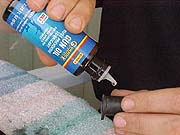
|
...and apply gun oil in the same manner as in previous steps. |

|
In the same manner as described previously, apply solvent to the slide stop pin... |

|
...and apply gun oil in the same fashion as has been applied to previous parts. |

|
Using the brass brush, clean the edges of the gun body. Wipe off all solvent
when done and apply a small amount of gun oil and wipe off all excess.
|
|
We are now ready to proceed with reassembling
the firearm.
|
|